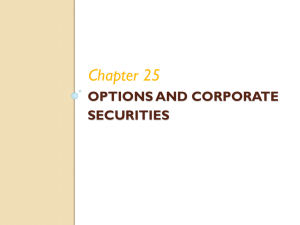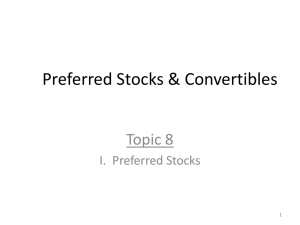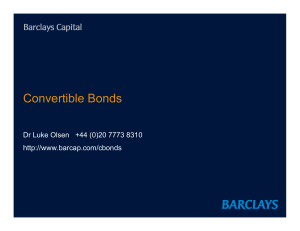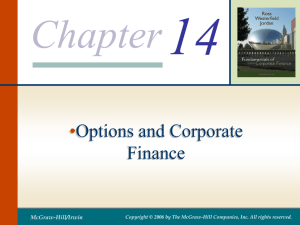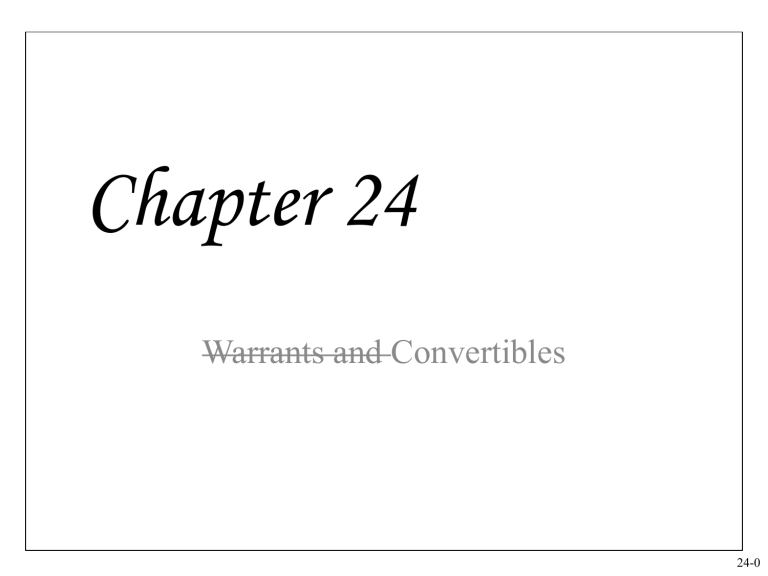
Chapter 24 Warrants and Convertibles 24-0 24.4 Convertible Bonds • A convertible bond is like a bond with warrants. • Convertible bond is ONE security. • A convertible bond… – Earns interest…like a straight bond – Can be converted to equity…like a warrant 24-1 24.5 The Value of Convertible Bonds The value of a convertible bond has three components: 1. straight bond value 2. conversion value 3. option value 24-2 The Value of Convertible Bonds Convertible Bond Value Convertible bond values Conversion Value floor value floor value = conversion ratio Straight bond value Option value Stock Price 24-3 Litespeed Inc. just issued a 10-year, 8% annual coupon convertible bond. The YTM on regular coupon bonds for companies with the same credit rating as Litespeed is 10%. The bond was just sold yesterday at par of $1,000. The bond is convertible into 25 shares of Litespeed stock with is currently priced at $12. 1.) What is the straight bond value? straight bond value = PV of coupons and face 2.) What is the conversion value? conversion value = current share price x shares 3.) What is the option value of the bond? option value = convertible bond value – MAX[straight bond value, conversion value] 24-4 Litespeed Inc. just issued a 10-year, 8% annual coupon convertible bond. The YTM on regular coupon bonds for companies with the same credit rating as Litespeed is 10%. The bond was just sold yesterday at par of $1,000. The bond is convertible into 25 shares of Litespeed stock with is currently priced at $12. 4.) What is the conversion price of the bond? conversion price = face value/conversion ratio 5.) What is the conversion premium? conversion premium = conversion price / stock price at issue - 1 24-5 24.6 Reasons for Issuing Warrants and Convertibles • A reasonable place to start is to compare convertible debt to both straight debt and straight equity. – Convertible vs. Straight debt – Convertible vs. Straight equity 24-6 Convertible Debt vs. Straight Debt • Convertible debt carries a lower coupon rate than does otherwise-identical straight debt. (if high RB these are attractive) • If the company subsequently does poorly, it will turn out that the conversion option finishes out-of-themoney. (just debt, owe coupons & face, S down) • But if the stock price does well, the firm would have been better off issuing straight debt. (oh well) 24-7 Convertible Debt vs. Straight Equity • If the company subsequently does poorly, it will turn out that the conversion option finishes out-of-themoney, but the firm would have been even better off selling equity when the price was high. (oh well) • But if the stock price does well, the firm is better off issuing convertible debt rather than equity. (equity sales takes place at higher price per share) 24-8 24.7 Why Are Warrants and Convertibles Issued? • Research shows…for convertibles… – bond ratings of firms using convertibles are lower – convertibles tend to be used by smaller firms with high growth rates and more financial leverage – convertibles are usually subordinated and unsecured. 24-9 24.7 Why Are Warrants and Convertibles Issued? • Matching Cash Flows – If financing is costly, it makes sense to issue securities whose cash flows match those of the firm’s needs. – Convertible bonds also allow young firms to delay expensive interest costs until they can afford them. – When firm is successful, conversion occurs, expensive dilution occurs, but this is when the firm can most afford it. 24-10 24.7 Why Are Warrants and Convertibles Issued? • Risk Synergy – Suppose the market does not know if the firm is a high risk or low risk firm. If a firm issues a convertible bond, then: • If high risk company – – Straight bond value is relatively low Option value is relatively high • If low risk company – – Straight bond value is relatively high Option value is relatively low – Conclusion: The market will pay a fair value even if it does not know what kind of firm it is. 24-11 24.7 Why Are Warrants and Convertibles Issued? • Backdoor Equity – Young, small, high growth firms cannot issue debt on reasonable terms due to high financial distress costs – However, owners may be unwilling to issue equity if current stock price is too low – So, they look to warrants/convertibles • Agency Costs – Convertible bonds reduce agency costs by aligning the incentives of stockholders and bondholders. – The incentive to take on excessive risk (with straight debt)…let’s do an example… 24-12 Convertible Bond Problem Ms. North is proposing to form a new start-up firm. She can invest in one of two projects. • The relatively safe project offers a 40 percent chance of a $9 million payoff and a 60 percent chance of an $8 million payoff. • The risky project offers a 20 percent chance of a $20 million payoff and an 80 percent chance of a $5 million payoff. • Ms. North initially proposes to finance the firm by an issue of straight bonds with a promised payoff of $7 million. Which project will she choose if she issues straight bonds? 24-13 Safe Project Safe project payoff Payoff to lender Payoff to Ms. North 60% 40% Expected $8.0 $9.0 $8.4 $7.0 $7.0 Risky Project Risky project payoff Payoff to lender Payoff to Ms. North 80% 20% Expected $5.0 $20.0 $8.0 $5.0 $7.0 • Ms. North will choose the risky project because her expected payoff is higher • The lender would want Ms. North to choose the safe project 24-14 • Suppose now that Ms. North offers to make the debt convertible into ¾ of the firm’s equity. • So lender has choice: $7 million debt payment or (3/4) ownership of equity • Which project does Ms. North choose if she finances the firm with convertible debt? 24-15 Safe Project Safe project payoff Payoff to lender - debt value - conversion value - lender chooses Payoff to Ms. North 60% $8.0 40% $9.0 $7.0 $7.0 Risky Project Risky project payoff Payoff to lender - debt value - conversion value - lender chooses Payoff to Ms. North 80% $5.0 20% $20.0 $5.0 $7.0 Expected $8.4 Expected $8.0 • Lender: Expected payoff is the same no matter which project chosen • Ms. North’s expected payoff is higher for safe project, she would choose safe project • Safe project has higher total expected payoff $8.4 vs. $8.0 24-16
